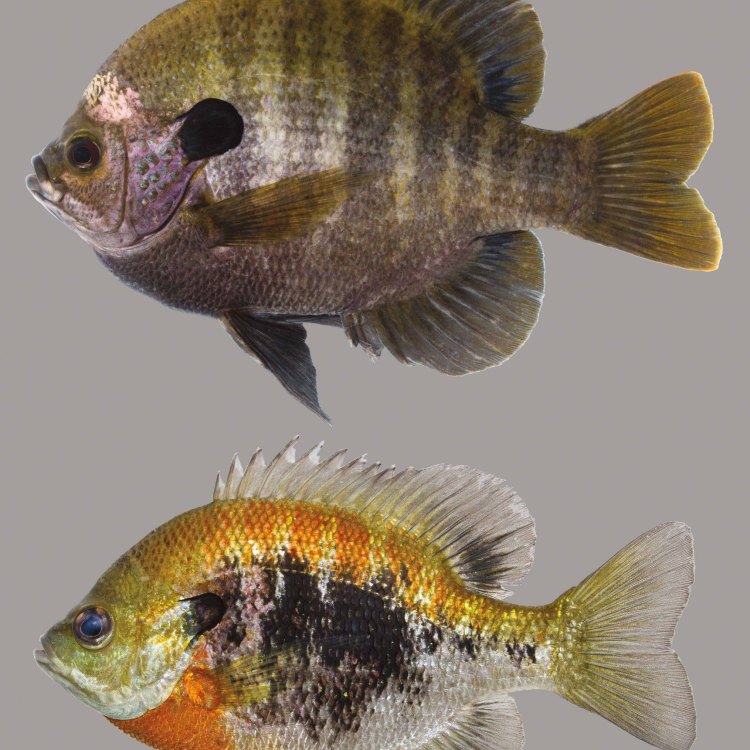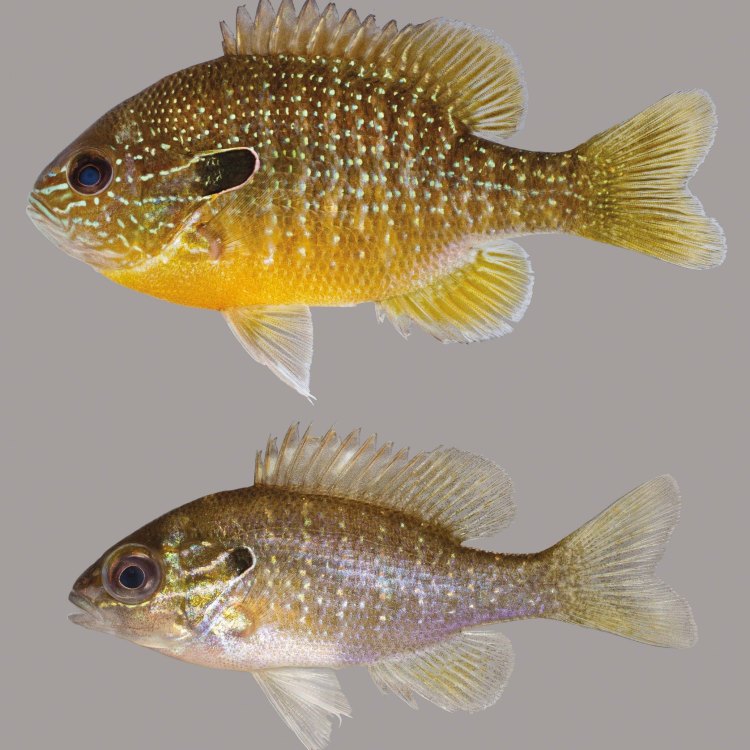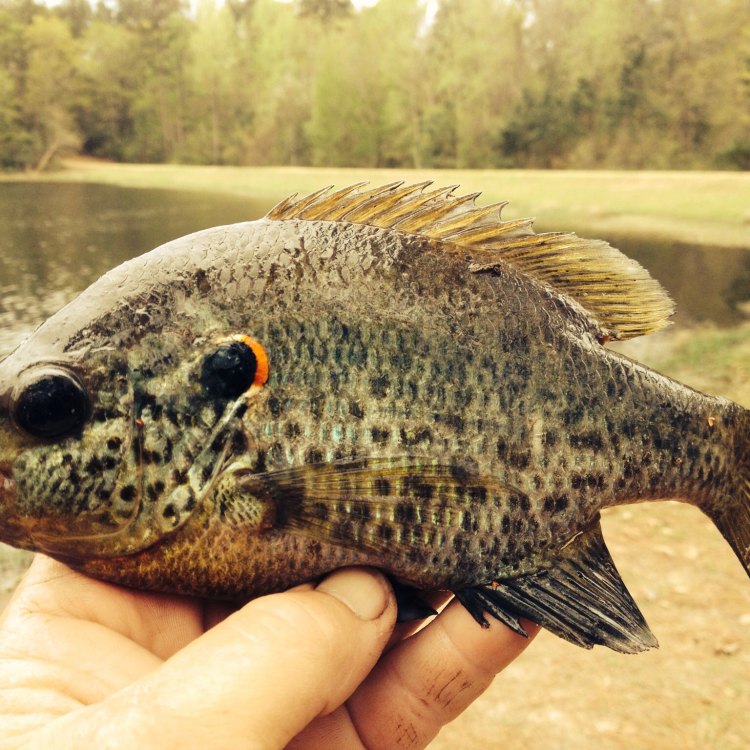
Freshwater Sunfish
4-12 inches
The Freshwater Sunfish, a member of the Centrarchidae family, can be found in Eastern and central United States. With a length of 4-12 inches and an oval, laterally compressed body shape, it is a popular catch among anglers. These colorful fish are known for their unique pattern and can be easily spotted in freshwater lakes and rivers. So if you're planning a fishing trip, keep an eye out for the charming Freshwater Sunfish!
Animal Details Summary:
Common Name: Freshwater Sunfish
Kingdom: Animalia
Habitat: Freshwater lakes, ponds, rivers, and streams
The Fascinating World of Freshwater Sunfish
The sun shimmers on the calm surface of a quiet lake, and as you look closer, you can see a school of small, colorful fish swimming below. One of the most common and beloved inhabitants of North American freshwater lakes, ponds, rivers, and streams is the freshwater sunfish.Known scientifically as Lepomis macrochirus, the freshwater sunfish is a member of the kingdom Animalia and belongs to the phylum Chordata. It is in the class Actinopterygii, which means it is a ray-finned fish, and it is in the order Perciformes, which includes perch, bass, and other popular sportfish Freshwater Sunfish. Freshwater sunfish is part of the family Centrarchidae, a group of small to medium-sized fish that can be found in various parts of the world.
A Diverse Habitat
One of the most remarkable things about freshwater sunfish is their adaptability to different habitats. They can be found in lakes, ponds, rivers, and streams all across North America, including Canada and Mexico. However, their primary range is the eastern and central United States, where they thrive in both freshwater and brackish waters.But what exactly makes a suitable habitat for these fish? They prefer slow-moving water with vegetation and structure, like roots or logs, to forage for food and hide from predators. They are also known to inhabit areas with sandy or muddy bottoms, which provide a perfect environment for the fish to build their nests.
An Omnivorous Diet
Freshwater sunfish are opportunistic feeders, meaning they will eat anything they can find. They have an omnivorous diet, which means they eat both plant and animal matter. They are known to feed on insects, small fish, crustaceans, and aquatic plants Freshwater Eel. This varied diet not only makes them adaptable to various habitats but also ensures their survival in both natural and man-made waters.Interestingly, their food preferences can change depending on the season. For example, during the summer months, they are more likely to feed on insects and small fish, while in the fall and winter, they may switch to a more plant-based diet.
The Colorful World of Freshwater Sunfish
One of the most striking features of freshwater sunfish is their vibrant coloration. While there are many different species of sunfish, they all have a similar oval and laterally compressed body shape. Their size can vary from 4-12 inches, depending on the species and their habitat.Their coloration can also vary depending on the species, but the most common colors are blue, green, or yellow with dark vertical bars. Some species also have bright colors on their fins and tails, making them even more eye-catching. These colors serve not only to attract mates but also to protect them from predators by camouflaging them in their surroundings.
A Vital Role in the Ecosystem
While some see freshwater sunfish as a small, unremarkable fish, they play a vital role in the ecosystem. As an essential part of the food chain, they help control the population of smaller fish and insects, and in turn, they are preyed upon by larger fish and aquatic animals.Moreover, their foraging and feeding habits also make them efficient algae eaters, helping to keep the waters clean and balanced. They are also a crucial food source for many other animals, from birds to mammals, and even other fish.
Their Incredible Nest-Building Abilities
Apart from their significant role in the ecosystem, freshwater sunfish are known for their impressive nest-building abilities. During the breeding season, male sunfish will build complex nests using small rocks, shells, and vegetation. These nests can take several hours to build and can be up to 3 feet wide.Once the nest is complete, the male will guard it fiercely, attracting a female with his colorful fins and intricate nest design. The female will then lay her eggs inside the nest, and the male will fertilize them. After the eggs hatch, the male will continue to guard the nest until the fry (baby fish) are ready to leave and start their own journey.
The Excitement of Fishing for Sunfish
Freshwater sunfish is a popular sportfish, and many anglers enjoy the thrill of catching this feisty, colorful fish. They can be caught using a variety of methods, including bait, lures, and flies. However, since they are small fish, they are often considered "panfish" and are an excellent choice for beginners and young anglers.Not only are they fun to catch, but they also make a delicious meal. They have a mild flavor and are easy to fillet, making them a popular catch among recreational fishermen and even commercial fisheries.
The Importance of Conservation
Unfortunately, like many other freshwater species, the population of freshwater sunfish is declining due to habitat destruction and pollution. Overfishing and the introduction of non-native species have also contributed to their decline. As a result, it is crucial to practice sustainable fishing and conservation efforts to ensure the survival of this incredible fish.It is also essential to note that some species of sunfish can become aggressive and dominate a body of water, leading to the decline of other native species. As responsible anglers and nature enthusiasts, it is our responsibility to protect the natural balance of ecosystems and prevent the spread of invasive species.
Conclusion
In conclusion, freshwater sunfish is a fascinating and vital part of North American freshwater ecosystems. From their diverse habitats and adaptable diet to their vibrant colors and remarkable nest-building abilities, these fish are truly incredible creatures. As we continue to learn more about these fish and their role in the ecosystem, it is vital that we also work towards their conservation to ensure that future generations can enjoy their beauty and importance in our waters. So next time you're out by the lake, take a moment to appreciate the colorful world of freshwater sunfish swimming below.

Freshwater Sunfish
Animal Details Freshwater Sunfish - Scientific Name: Lepomis macrochirus
- Category: Animals F
- Scientific Name: Lepomis macrochirus
- Common Name: Freshwater Sunfish
- Kingdom: Animalia
- Phylum: Chordata
- Class: Actinopterygii
- Order: Perciformes
- Family: Centrarchidae
- Habitat: Freshwater lakes, ponds, rivers, and streams
- Feeding Method: Omnivorous
- Geographical Distribution: North America
- Country of Origin: United States
- Location: Eastern and central United States
- Animal Coloration: Varies depending on species, but commonly blue, green, or yellow with dark vertical bars
- Body Shape: Oval and laterally compressed
- Length: 4-12 inches

Freshwater Sunfish
- Adult Size: 5-7 inches
- Average Lifespan: 3-5 years
- Reproduction: Sexual
- Reproductive Behavior: Males build nests and attract females through courtship displays
- Sound or Call: Males may produce sounds during courtship or defending territory
- Migration Pattern: Some species migrate short distances
- Social Groups: Solitary or form small groups during spawning
- Behavior: Active during the day, often found near the water's surface
- Threats: Pollution, habitat destruction, invasive species
- Conservation Status: Not evaluated (IUCN)
- Impact on Ecosystem: Important prey for larger fish and birds
- Human Use: Fishing, aquaculture
- Distinctive Features: Sparkling coloration, long and pointed fins
- Interesting Facts: Some species of freshwater sunfish can change their coloration depending on their mood or the environment
- Predator: Large fish, birds

Lepomis macrochirus
The Fascinating World of Freshwater Sunfish
When you think of fish, images of majestic and colorful creatures usually come to mind. But have you ever heard of freshwater sunfish? These small but mighty fish have been gaining popularity among fish enthusiasts, and it's not hard to see why. With their sparkling coloration, unique behavior, and interesting features, freshwater sunfish are truly fascinating creatures. Let's dive into the world of freshwater sunfish and learn more about these amazing fish PeaceOfAnimals.Com.What is a Freshwater Sunfish?
Freshwater sunfish, also known as pond sunfish, are a group of fish that belong to the family Centrarchidae. They are commonly found in North and Central America, and some species have been introduced to other parts of the world for sport fishing or aquaculture purposes. These fish are mostly found in slow-moving or still bodies of water such as streams, ponds, and lakes.There are many different species of freshwater sunfish, with some of the most well-known being bluegill, pumpkinseed, and green sunfish. They are generally small in size, with the average adult size ranging from 5 to 7 inches. However, some species can grow up to a foot long.
Reproduction and Behavior
Like many other fish, freshwater sunfish reproduce sexually. Interestingly, their reproductive behavior is quite unique. During breeding season, male sunfish will build nests on the bottom of the water using plants, sticks, and pebbles Flat Coated Retriever. They will then use courtship displays to attract females to their nests. These displays can include flaring their fins, changing coloration, and even producing sounds.Speaking of sounds, it may come as a surprise that some species of freshwater sunfish can produce sounds during courtship or when defending their territory. These sounds are produced by rubbing their specialized muscles against their swim bladder. It is believed that these sounds play a role in mate selection and territory defense.
Freshwater sunfish are also known for their social behavior. While they are typically solitary fish, they will form small groups during breeding season. This behavior allows them to have a higher chance of successfully reproducing as there is strength in numbers. They are also active during the day, and can often be seen near the water's surface.
Distinctive Features
One of the most striking features of freshwater sunfish is their coloration. Their body varies in shades of green, blue, and brown, with a speckled or sparkly pattern. In some species, the male sunfish will develop brighter colors and markings during breeding season to attract females. Interestingly, some species of sunfish can change their coloration depending on their mood or environment.In addition to their sparkling coloration, freshwater sunfish are easily recognizable by their long and pointed fins. These fins, particularly the dorsal fin, are used for swimming and steering. They also play a role in courtship displays and territorial defense.
Migration Pattern
While some species of freshwater sunfish are considered permanent residents of their water body, others may migrate short distances. The exact reason for their migration is still unknown, but it is believed to be related to food availability or water temperatures.Threats and Conservation Status
Like many other aquatic species, freshwater sunfish face various threats. Pollution, habitat destruction, and the introduction of invasive species are some of the main threats to their survival. These fish are also often caught in fishing nets or as bycatch.The conservation status of freshwater sunfish is not yet evaluated by the International Union for Conservation of Nature (IUCN). However, it is important to protect their habitats and ensure sustainable fishing practices to maintain their populations in the wild.
Impact on Ecosystem and Human Use
Freshwater sunfish play an important role in their ecosystems as they are an important source of prey for larger fish and birds. Their ability to control insect populations also contributes to the balance of the ecosystem.Aside from their ecological importance, freshwater sunfish also have economic value. They are popular among recreational fishermen and are also raised in aquaculture for food. However, it is important to regulate fishing practices and ensure sustainable harvest to prevent overexploitation of these fish.
Predators
As with any other animal, freshwater sunfish also have predators. Large fish and birds, such as bass and herons, are known to feed on sunfish. These predators play an essential role in controlling the population of sunfish, ensuring a healthy balance in the ecosystem.Intriguing Facts
Apart from their distinctive features and fascinating behavior, freshwater sunfish also have a few interesting facts worth knowing. Did you know that they can live up to 3 to 5 years in the wild? While their lifespan may seem short compared to other fish species, it is still impressive considering their small size.Furthermore, some species of freshwater sunfish have been known to hybridize, resulting in unique and sometimes sterile offspring. This process occurs when two different species of sunfish come in contact during breeding season.
The Delightful Freshwater Sunfish
In conclusion, freshwater sunfish may not be as popular as other fish species, but they are undoubtedly fascinating creatures with their sparkling coloration, unique behavior, and interesting features. These small and mighty fish play an important role in their ecosystems and have economic value for human use. By understanding and protecting their habitats, we can ensure their survival for many generations to come. So next time you come across a freshwater sunfish, take a moment to appreciate their beauty and significance in our natural world.

The Fascinating World of Freshwater Sunfish
Disclaimer: The content provided is for informational purposes only. We cannot guarantee the accuracy of the information on this page 100%. All information provided here may change without prior notice.












